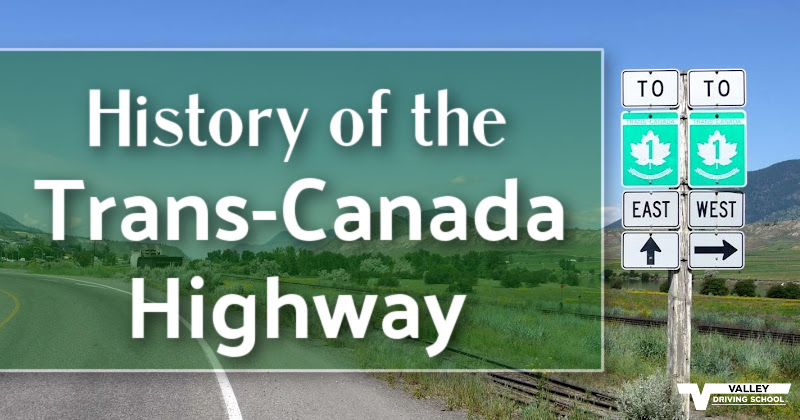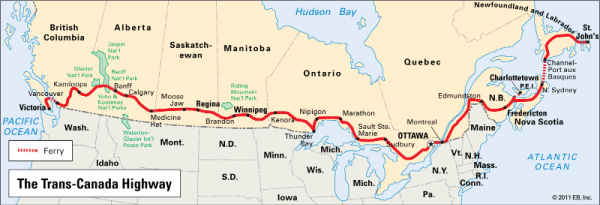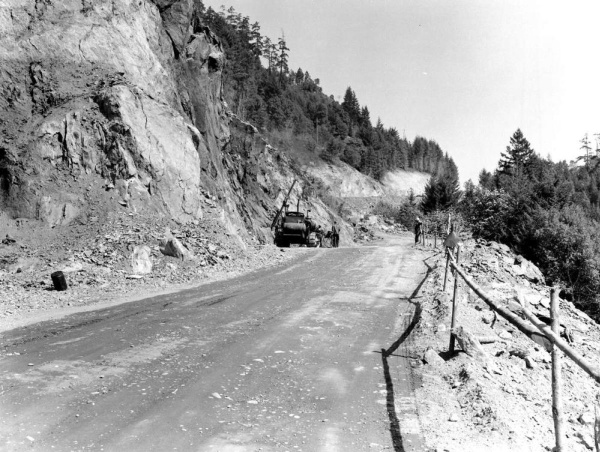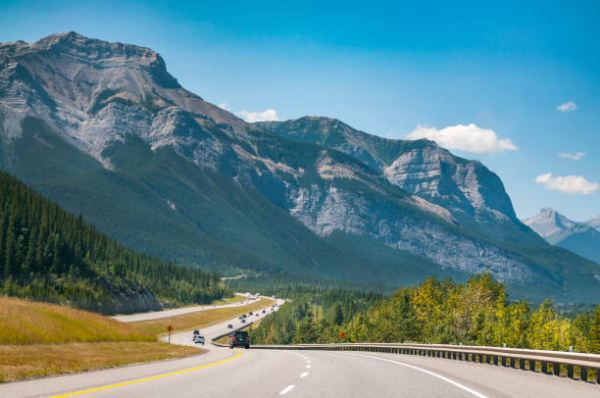Although the proposal for a transcontinental highway was first made in 1912, it was only after World War II that Canada’s automobile industry began to grow and efforts were then made to construct one roadway that would connect the major cities across the country. The Trans-Canada Highway now stretches from the Pacific Ocean to the Atlantic Ocean, crossing through all of Canada’s 10 provinces and spanning across almost 8,000 kilometres.

Explore the history of the Trans-Canada Highway with us as we take a look at its expansive construction undertaking that started more than 70 years ago!
Connecting the Provinces
The idea for a transcontinental highway in Canada was first proposed by a man named Thomas Wilby in 1912. Wilby was an adventurer and journalist who had traveled across Canada by car, and he recognized the need for a national highway that would connect the country from coast to coast. His proposal received support from many Canadians, but it would take several decades before the government officially announced plans to build the Trans-Canada Highway in 1949.
In 1949, Prime Minister Louis St-Laurent passed the Trans-Canada Highway Act, which aimed to encourage and assist in the construction of a national highway system connecting all ten Canadian provinces and major cities for easy transportation.

The chosen route began in Victoria and connected with Vancouver before heading eastward, passing through cities such as Calgary, Regina, Winnipeg, Thunder Bay, Ottawa, Montreal, Quebec City, Fredericton, Moncton, Charlottetown, Sydney and St. John’s. Ferries connected Vancouver Island and Newfoundland to the main route.
The Trans-Canada Highway Act established standards and provided half of the funding for the highway system, with the remaining funding and work becoming the responsibility of the provinces. In 1956, the federal government's share of funding increased to 90% when a cost-sharing agreement was reached with the provincial governments to upgrade existing roadways to "Trans-Canada" standards. This was particularly important for areas such as British Columbia, the rugged Canadian Shield north of Lake Superior, and much of Newfoundland, where terrain made building and upgrading roads challenging.
Building the Trans-Canada Highway

Construction of the Trans-Canada Highway began in 1950 with a set deadline for completion by 1956. However, much of the construction was still underway until 1971. Despite this, portions of the highway were opened in 1962 by Prime Minister John Diefenbaker.
Delays in construction were caused by provincial negotiations and various challenges. One such challenge was connecting Sault Ste. Marie and Wawa in Ontario, along the shores of Lake Superior. The area had no existing roads, and the region's muskeg swamps were difficult to work around. Twenty-five bridges and tons of gravel were required to create a solid road base for building the highway in the area.
There was also difficulty building the highway through Rogers Pass between Revelstoke and Golden in British Columbia. With an average of 8.5 meters of snow per year, the area of Rogers Pass sees multiple avalanches a year. During the building of the Trans-Canada Highway, snow sheds (roadway coverings) were installed to protect the roadway from avalanches and snow.
Saskatchewan was the first province to complete its section of the Trans-Canada Highway in 1957. One section in Newfoundland took until 1965, and up to half of the length of the highway was not yet paved. In 1971, the Trans-Canada Highway was completed to the standards laid out in the Trans-Canada Highway Act of 1949.
Twinning the Trans-Canada Highway

Over the years, the Trans-Canada Highway has required updates. A significant focus has been on “twinning” the highway, which involves adding two lanes in each direction divided by a median.
Each province has implemented a twinning upgrade, starting with the major population centres. Twinning across the Prairies is mostly complete, including Alberta and its National Parks. Bypasses have been built around Moose Jaw, Regina, Portage la Prairie, Brandon and Winnipeg. The Calgary ring road (Stoney Trail/ Highway 201) is expected to be completed in 2024.
Upgrades and extensions of the Trans-Canada Highway in Quebec are expected to be completed by 2026, and twinning to the highway in Nova Scotia is expected to be completed in 2023.
As with the initial construction of the Trans-Canada Highway, there are difficulties with twinning the highway in British Columbia and Ontario. In British Columbia, Highway 1 on Vancouver Island and in the Lower Mainland is twinned. The Coquihalla #5 was built to connect Hope to Kamloops by a twinned route. This was built as the Fraser River Canyon does not have terrain suitable for twinning.
Currently, there is a program in place to twin the Trans-Canada Highway between Kamloops and Alberta, where the terrain allows. In places where twinning is not possible, 3-lanes will be built with alternative passing lanes. Phase 4 of the Kicking Horse Canyon Project is underway, which will complete the last un-twinned section east of Glacier National Park.
The challenge in Ontario is how much roadway needs to be upgraded. Over 1,900 kilometres of Highway 17 across the province needs to be twinned. Currently, Ontario is completing the twinning of Highway 69 from Parry Sound to Sudbury to extend Highway 400 north from Toronto to Sudbury.
Additional Upgrades to the Trans-Canada Highway
Along with twinning, additional highways were built to create more routes that run across Canada. Two routes run from Nova Scotia to New Brunswick, including one which travels to Prince Edward Island across the Confederation Bridge.
There are also two routes that begin west of Montreal and a few routes through Ontario. Heading west, the main Trans-Canada Highway (Highway 1) passes through Winnipeg, Regina, Calgary and Banff. It then takes the highly scenic Kicking Horse Pass through the Canadian Rockies and continues through Kamloops to Vancouver Island.
–
Currently, the Trans-Canada Highway totals about 12,800 km of paved roads across 10 provinces. The main route, at 7,821 km, is the world’s fourth-longest highway, so get out there and explore! If you’re looking to make the trip from coast to coast , we have all the best places to stop along the way .
